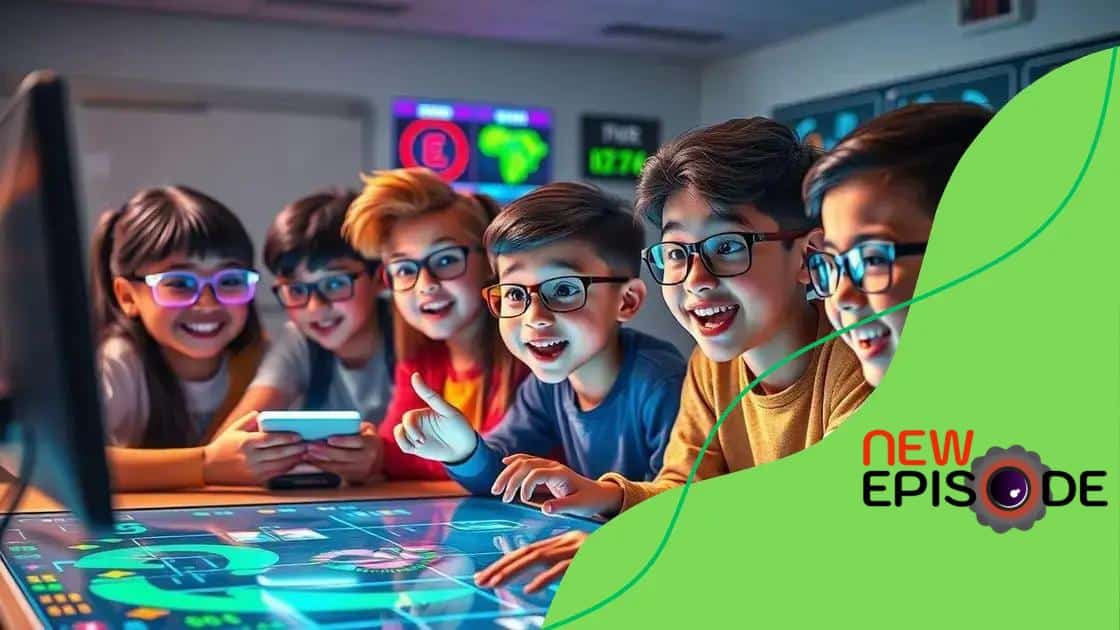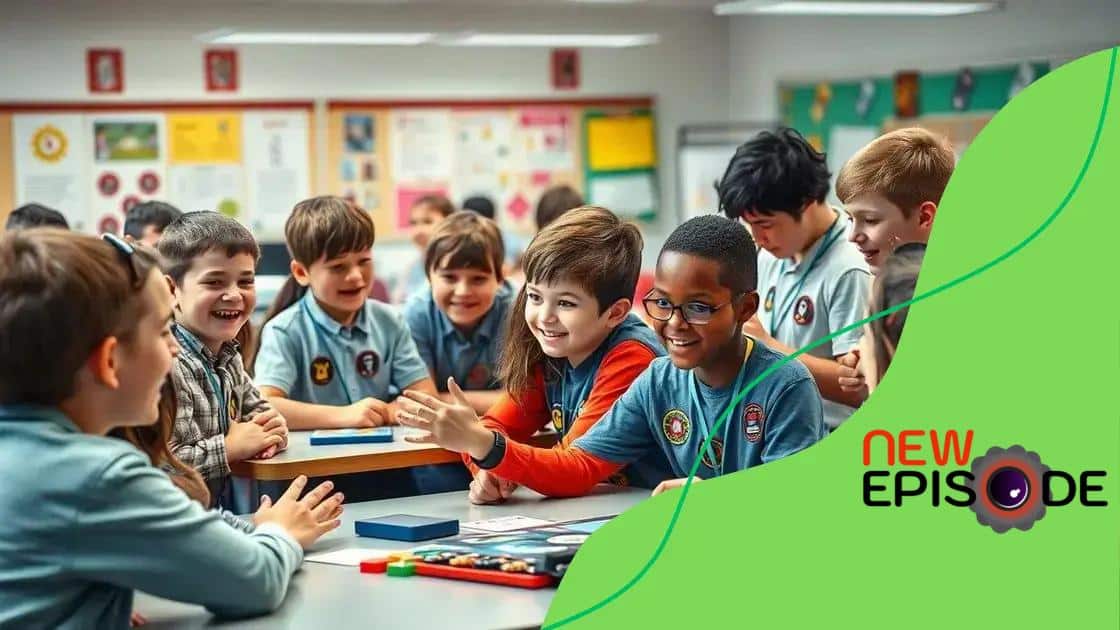How gamification is enhancing student engagement

Gamification enhances student engagement by incorporating game elements like points, badges, and quests into learning, leading to increased motivation and improved academic performance.
How gamification is enhancing student engagement is a trend shaking up classrooms everywhere. Have you ever wondered how game-like elements can make learning more fun? Join me as we dive into this fascinating approach that is captivating students worldwide.
Understanding gamification in education
Understanding gamification in education is crucial for leveraging its potential to engage students effectively. Gamification incorporates game design elements into non-game contexts, especially learning environments. This approach can motivate and enhance students’ experiences in the classroom.
At the core of gamification is the idea that adding game-like features can make learning more attractive. Think about how rewarding achievements and tracking progress can transform the way students interact with their subjects. When students are presented with challenges in the form of games, their enthusiasm for learning increases.
Key Elements of Gamification
- Points: Points reward students for completing tasks, motivating them to engage more.
- Badges: Badges celebrate achievements, giving students a sense of accomplishment.
- Levels: Levels can indicate progress and encourage students to reach higher goals.
- Leaderboards: Friendly competition can motivate students to improve their understanding.
Utilizing these elements helps in creating an environment where students feel involved and valued. By integrating these concepts, educators can see a noticeable improvement in class participation.
Moreover, it is important to recognize that not all students respond to gamification in the same way. Some may find the competitive aspects motivating, while others may feel stressed by leaderboards. Hence, finding a balance is key. Providing different options and levels of engagement can cater to various student preferences.
As gamification enhances student engagement, it promotes creativity and collaboration among classmates. Students often work in groups, sharing knowledge and ideas while completing tasks. This collaborative aspect is one of the significant benefits of gamifying education.
Implementing Gamification Effectively
To implement gamification effectively in classrooms, teachers can start small. They might begin with a single unit and gradually incorporate game elements into more lessons. Additionally, gathering feedback from students helps in understanding what works and what doesn’t.
While gamification can significantly enhance learning, it’s essential to align activities with learning objectives. The focus should remain on educational outcomes, ensuring that the games serve as tools rather than distractions.
Benefits of gamification for students
Exploring the benefits of gamification for students reveals how this approach can transform learning experiences. By integrating game mechanics into educational settings, students become more engaged and motivated to participate. This shift can lead to improved academic performance and a greater enthusiasm for learning.
One major advantage of gamification is that it encourages collaboration among students. In gamified environments, learners often work together to overcome challenges, fostering teamwork and communication skills. This collaboration nurtures a supportive classroom culture that can enhance social skills.
Enhanced Motivation
- Immediate Feedback: Gamification provides real-time feedback on performance, allowing students to understand their progress instantly.
- Increased Engagement: Game-like elements capture students’ attention, making learning more enjoyable.
- Goal Setting: The ability to set and achieve goals innovatively can boost students’ confidence.
Moreover, gamification can create a sense of competition that encourages students to put in more effort. Friendly competition among peers can elevate their desire to excel academically. Students often strive to earn higher scores or badges, motivating them to stay focused on their studies.
Another significant benefit is the ability to personalize learning. Teachers can customize game mechanics to meet individual student needs. By offering different pathways for learning, educators can cater to various learning styles. This tailored approach ensures that all students have a fair opportunity to succeed.
Gamification also promotes critical thinking skills by presenting students with complex problems to solve. These challenges often require creative solutions, encouraging learners to think outside the box. Such problem-solving experiences are invaluable as they prepare students for real-world scenarios.
Building Resilience
Additionally, gamification helps students develop resilience. In games, failure is often a part of the learning process, teaching students the importance of perseverance. This mindset can lead to a more positive attitude toward challenges in and out of the classroom.
Incorporating gamification into education not only enhances engagement but also prepares students for future success. By embracing this innovative approach, educators can unlock a range of benefits that positively impact student learning and development.
Practical examples of gamification techniques

Implementing practical examples of gamification techniques can significantly enhance student engagement in the classroom. These techniques help to make learning more interactive and enjoyable. Let’s explore some effective strategies that educators can use to incorporate gamification into their teaching practices.
One popular technique is using digital badges. Badges serve as visual rewards for achieving specific goals. When students earn badges for completing assignments or mastering new skills, they feel a sense of accomplishment. This recognition can motivate them to strive for more achievements.
Examples of Gamification Techniques
- Point Systems: Assign points to various activities, such as homework completion or class participation, allowing students to track their progress.
- Leaderboards: Display a leaderboard in the classroom showing student standings based on points earned. This encourages healthy competition.
- Quests or Challenges: Frame learning objectives as quests, where students must complete specific tasks to progress and earn rewards.
- Storytelling: Create a narrative around the lessons, allowing students to engage with the content through characters and plot.
Another compelling technique is incorporating role-playing games (RPGs) into lessons. Students can assume roles within a story, where they must use knowledge and skills to navigate challenges. This approach not only engages students but also fosters creativity and critical thinking.
Using interactive quizzes can also be effective. These quizzes can be gamified with timers, points, and lifelines, making assessments more exciting and less stressful for students. When quizzes are fun, students are more likely to participate and retain information better.
Additionally, educators can use simulation games that mimic real-world scenarios related to the subject matter. For instance, a business simulation can help students understand economics in a hands-on manner. By experiencing realistic situations, students gain practical knowledge.
Moreover, incorporating team-based activities encourages collaboration and communication. Teams can compete to complete challenges or solve problems, promoting teamwork and shared learning objectives. This strategy not only makes learning enjoyable but also mirrors real-world collaboration.
By experimenting with these strategies, teachers can find the best fit for their classrooms. The goal is to create an engaging environment where students feel motivated to participate and learn. As gamification techniques continue to evolve, educators have endless opportunities to enrich the learning experience.
Challenges in implementing gamification
Exploring the challenges in implementing gamification reveals several obstacles educators face. While gamification has many benefits, it also comes with hurdles that require careful planning and execution. Understanding these challenges helps educators prepare better for integrating gamified elements into their teaching.
One of the primary challenges is the need for resources and training. Educators may not have the necessary tools or knowledge to implement gamification effectively. Without proper professional development, they might struggle to apply game design principles in a meaningful way. Training sessions and workshops can be crucial for equipping teachers with the skills they need.
Technical Issues
- Technology Access: Schools may lack the necessary technology, making it difficult for students to engage with digital gamified content.
- Software Compatibility: Not all software tools work seamlessly with existing systems, causing frustrations and disruptions.
- Technical Support: Insufficient IT support can hinder the implementation process, leading to delays or failure.
Another significant issue is the diversity of student needs. Not every student responds to gamification in the same way. Some may thrive in a competitive environment, while others may feel anxious or overwhelmed. Educators must be mindful of these differences and offer varied options to meet students’ individual learning preferences.
Moreover, game mechanics can sometimes overshadow educational objectives. When the focus shifts too much toward the game aspect, students may lose sight of the learning goals. It is crucial for educators to maintain a balance between fun and learning to ensure effective educational experiences.
Additionally, there can be resistance from stakeholders, including parents and school administrators. Some individuals may question the effectiveness of gamification or be skeptical about its impact on learning. Gaining buy-in from all parties is essential for successful implementation.
Time Constraints
- Curriculum Integration: Finding the right time to incorporate gamification into an already packed curriculum can be challenging.
- Preparation Time: Creating or adapting gamified lessons requires significant effort, which can be overwhelming for teachers.
- Assessment Alignment: Aligning gamified activities with assessment standards takes time and planning.
In summary, while gamification can transform the learning experience, educators must navigate various challenges. By being aware of potential obstacles such as resource availability, technical issues, and differing student needs, teachers can plan effectively. Addressing these challenges is critical for making gamification a successful part of the educational process.
Measuring the impact of gamification on learning
Measuring the impact of gamification on learning is essential to understand its effectiveness in educational settings. There are various methods to evaluate how gamification influences student engagement and academic performance. By analyzing data and feedback, educators can make informed decisions about continuing or adapting their gamified approaches.
One common way to measure impact is through student performance metrics. Teachers can track grades and completion rates before and after implementing gamification. This comparison provides insight into whether gamified elements have a positive influence on learning outcomes.
Assessment Tools
- Quizzes and Tests: Regular quizzes can help monitor knowledge retention and engagement levels.
- Surveys: Gathering student feedback through surveys can also shed light on their experiences and engagement.
- Participation Metrics: Analyzing participation levels during various activities can indicate how gamification affects involvement.
Additionally, qualitative data plays a crucial role. Conducting interviews or focus groups with students can provide deeper insights into their feelings about learning through gamification. Listening to their thoughts can help educators fine-tune gamified experiences to better meet their needs.
Another effective method is through the use of control groups. Comparing a class using gamification to a class that uses traditional teaching methods offers a clear picture of what works best. The differences in engagement, motivation, and learning outcomes can highlight gamification’s strengths and weaknesses.
Tracking Engagement
Engagement can also be measured through tools that track student interactions. Learning management systems often provide analytics on student behavior, showing how often they log in and participate in activities. Analyzing this data helps educators see trends and identify areas where students may struggle.
Finally, long-term studies can show how sustained gamification impacts student achievement over time. This research can reveal whether initial engagement leads to lasting changes in attitudes toward learning or if novelty wears off.
By measuring the impact of gamification effectively, educators can enhance the learning experience and make informed decisions about future implementation. Continuous assessment ensures that gamified methods are not only engaging but also educationally beneficial.
FAQ – Frequently Asked Questions about Gamification in Education
What is gamification in education?
Gamification in education is the use of game design elements in learning environments to increase engagement and motivation among students.
How can gamification improve student learning outcomes?
Gamification improves learning outcomes by making lessons more interactive, encouraging participation, and providing immediate feedback through game mechanics.
What are some common gamification techniques used in classrooms?
Common techniques include point systems, badges, leaderboards, quests, and interactive quizzes that promote student involvement and competition.
How do I measure the impact of gamification on students?
You can measure the impact by analyzing performance metrics, conducting surveys, using control groups, and tracking engagement through learning management systems.






